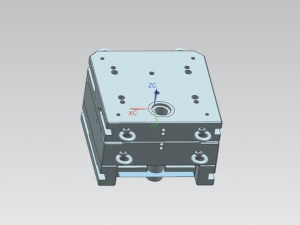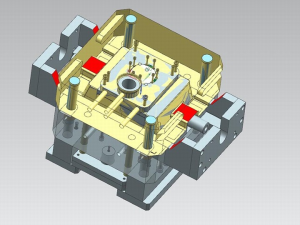The process cycle of a die casting trimming mold consists of 5 main stages, as described below. The total cycle time is very short, usually between 2 seconds and 1 minute.
clamp
- The first step is the preparation and clamping of the mold 2 halves. Each mold half is first cleared from the previous shot and then lubricated to facilitate ejection of the next part. Lubrication time varies with part size and number of cavities and side cores increases with the increase in .When injecting metal, enough force must be applied to the mold to close it securely. The time it takes to close and clamp the mold depends on the machine - larger machines (those with more clamping force) will require more Time. This time can be estimated from the dry cycle time of the machine.
injection
- The molten metal kept at a set temperature in the furnace is then transferred into a cavity where it can be injected into the mold. The method of transferring the molten metal depends on the type of die casting machine, whether a hot or cold chamber machine is used. The differences are detailed in the next section. Once transferred, the molten metal is injected into the mold at high pressure. Typical injection pressures range from 1,000 to 20,000 psi. This pressure holds the molten metal in the mold during solidification. The amount of metal is called the shot size. The shot time is the time it takes for the molten metal to fill all the channels and cavities in the mold. This time is very short, typically less than 0.1 seconds, to prevent premature solidification of any part of the metal. Proper shot time Can be determined by the thermodynamic properties of the material as well as the wall thickness of the casting. Larger wall thicknesses will require longer injection times. In the case of a cold chamber die casting machine, the injection time must also include manually scooping the molten metal into the die casting chamber time.
cool down
- The molten metal injected into the mold begins to cool and solidify once it enters the mold cavity. When the entire cavity is filled and the molten metal solidifies, the final shape of the casting is formed. The mold cannot be opened until the cooling time has elapsed and the casting has solidified The cooling time can be estimated from several thermodynamic properties of the metal, the maximum wall thickness of the casting and the complexity of the mold. Larger wall thicknesses will require longer cooling times. The geometric complexity of the mold will also require longer cooling times , because of the additional resistance to heat flow.
catapult
- After a predetermined cooling time, the mold halves can be opened, and the ejector mechanism can push the casting out of the mold cavity. The time to open the mold can be estimated from the dry cycle time of the machine, while the ejection time is determined by the size of the casting shell and should be Includes the time the casting is out of the mold. The ejector mechanism must apply some force to eject the part, as the part shrinks and sticks to the mold during cooling. Once the casting is ejected, the mold can be clamped shut for the next time injection.
prune
- During the cooling process, the material in the mold channels solidifies and adheres to the casting. This excess material, along with any flash that has occurred, must be trimmed from the casting by hand cutting or sawing, or using a trimmer . The time required for die casting trimming molds to trim excess material can be estimated based on the size of the casting housing. Scrap from this trimming is either discarded or can be reused in the die casting process. Recycled material may need to be reconditioned to the appropriate chemical ingredients, which can then be combined with non-recycled metals and reused in the die casting process.





